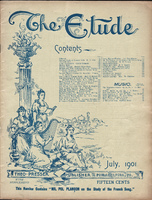I shall not attempt an exhaustive treatment of my subject, but shall only discuss, first, the art of registrating a pipe-organ in connection with congregational hymn-singing, and, second, as an accompaniment for a mixed quartet choir. I feel sure that the devout organist cannot give too much thought to these two branches of his work, for? it is just here that he has the opportunity to make the organ, what it ought always to be, the inspiration and support of true worship.
Why are the playing and the singing of hymn-tunes in our churches so often unsatisfactory? One cause is that the organist fails to obtain suitable sustaining combinations in his registration. The organist must know his organ’s capacities just as a singer knows her vocal powers; must feel deeply the sentiment of each line of the hymn, and must be so practiced in expressing his feelings upon his instrument that he can instantly find the registration that best meets his wants. The sustaining tones of all organs are produced by stops of 8-feet tone. The 8-feet stops usually found on the Swell Manual are Open Diapason, Stopped Diapason, Salicional, Æoline, Voix Celeste, Oboe, and Cornopean. Those to be found on the Great are Open Diapason, Gamba, Doppel-Flute, and Trumpet. The third manual, or Choir, usually has a Dulciana, Dolcissimo, Gedackt, and Clarinet. Of these stops the Oboe, Cornopean, Clarinet, and Trumpet are reeds. The effect of a combination produced by drawing all the 8-feet stops of an organ except the reeds would be simply solid, but lacking in richness or brightness. In other words, a combination of no character and colorless. Try it, and see for yourself. Then draw all the 4-feet stops, and notice how much brighter the effect is. Then add the reeds, and take note of the effect produced. In registrating for hymns it should be the endeavor of the organist to combine sustaining, bright, and rich effects judiciously. No matter whether a “forte,” “mezzo-forte,” or “piano” is desired, those three essential characteristics should be united. The Pedal should be deep and resonant, and always coupled to either the Swell or Great Manual, which all organists know.
I will name some good combinations for hymn- tunes. For a forte effect I like the following:
BOTH HANDS ON GREAT MANUAL.
Swell Manual: Full without 16-feet stops.
Great Manual: Open Diapason (8), Gamba (8), Doppel-Flute (8), Flute Harmonique (4), Octave. (4), Fifteenth (2).
Pedal: Bourdon (16), Open Diapason (16), ’Cello (8).
Couplers: Swell to Great and Great to Pedal.
The following is a fine mezzoforte:
BOTH HANDS ON GREAT MANUAL.
Swell: All 8- and 4-feet stops.
Great: Soft 8- and 4-feet stops (Gamba, Doppel-Flute, and Flute Harmonique).
Pedal: Bourdon (16), Open Diapason (16).
Couplers: Swell to Great and Great to Pedal.
For a piano effect I prefer using the Swell Manual alone, with Pedal coupled to Swell. Full Swell without the Cornopean, which is a loud-voiced reed, is my preference.
Some organists will undoubtedly think it queer that I have said nothing about 16-feet stops. I do not believe that a congregation is aided by their use. At all events the Open Diapason (16) on the Great should not be employed unless the hymn is in a high key. Before taking up quartet accompaniment I wish to impress upon inexperienced organists the necessity of playing hymn-tunes legato in both manuals and pedals. Smooth and connected playing is very soothing, but choppy work makes a congregation uneasy.
The organ bears the same relation to the quartet that an appropriate frame does to the picture within it. It furnishes a setting for the voices which should always enhance their effect, but never call the attention of the listener away from them to itself. Stops must be used which express the tonality in a definite manner, otherwise the singers are inclined to flat. The organ should be loud enough so that the members of the quartet can hear it at all times. Such soft stops, therefore, as the Æoline, Dolcissimo, and Dulciana, when used alone, are too subdued to be of any support to a quartet, although they are sometimes sufficient as a background to a very soft solo passage or in delicate prayer responses.
Take the opening bars of “O, Saviour of the World” (Goss) as an example of a good mezzopiano accompaniment for a church quartet. The registration which seems to meet the requirements best is:
Swell: Stopped Diapason and Flute Harmonique in combination, coupled to Pedal Bourdon (16) and Gedackt (8). The Stopped Diapason cannot be used alone, because it is of such a dry quality that it does not express the tonality clearly. A soft flute of 4 feet used with it makes the result bright and pleasing.
An effective mezzoforte support for a quartet is as follows:
Swell: Stopped Diapason, Salicional, Flute Harmonique, Open Diapason, and Oboe, coupled to Pedal Bourdon and Open Diapason. A combination of full swell without 16-feet stops, coupled to the Great Doppel-Flute, is about as strong a background as a mixed quartet can bear.
An artistic use of the balanced-swell pedal is a very beautiful and effective addition to well-chosen registration. All organists should study the voices of the singers, in order to learn which stops, whether diapasons, reeds, or flutes, enhance them the most. In what I have written I have trifed to give the results of my own observation and experience, and I trust it may be helpful to other organists.—John Hermann Loud.



